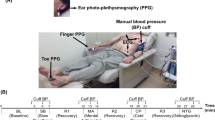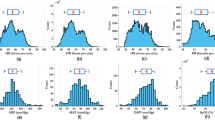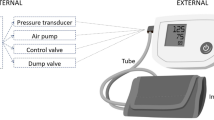Abstract
Pulse transit time (PTT) is defined as the time it takes the blood pressure (BP) wave to propagate from the heart to a specified point on the body. After an initial BP measurement, PTT can track BP over short periods of time. This paper evaluates two PTT algorithms: Chen’s and Poon’s algorithm; two of the most cited works in the area. The criteria for evaluating them were: which was capable of best tracking changes in BP and which provided the longest time between subsequent BP measurements. These establish the suitability of the PTT method for practical applications, which has not been examined previously. Accuracy was evaluated using the Association of Advancement of Medical Instrumentation (AAMI) and the British Hypertension Society’s (BHS) standards. Results show that Chen’s algorithm is dependent on its lookup table at short intervals but remains accurate using a 6-min calibration interval, with r=0.96 and r2=0.98. Poon’s algorithm fails when using a 2-min calibration interval, but is more capable of reflecting changes in BP. The short calibration interval and accuracy limit the usefulness of calculating BP using PTT. Therefore, neither of the algorithms can be recommended because of their shortcomings when estimating BP.
This is a preview of subscription content, access via your institution
Access options
Subscribe to this journal
Receive 12 digital issues and online access to articles
$119.00 per year
only $9.92 per issue
Buy this article
- Purchase on Springer Link
- Instant access to full article PDF
Prices may be subject to local taxes which are calculated during checkout





Similar content being viewed by others
References
Shapiro D, Jamner LD, Lane JD, Light KC, Myrtek M, Sawada Y et al. Blood pressure publication guidelines. Psychophysiology 1996; 33 (1): 1–12.
Fleming PR . A Short History of Cardiology. Rodopi Bv Editions,, Amsterdam, Atlanta, GA 1997 XVII, 241pp.
O'Brien E, Asmar R, Beilin L, Imai Y, Mallion JM, Mancia G et al. European Society of Hypertension recommendations for conventional, ambulatory and home blood pressure measurement. J Hypertens 2003; 21 (5): 821–848.
Yan IRF, Poon CCY, Zhang YT . A protocol design for evaluation of wearable cuff-less blood pressure measuring devices. Conf Proc IEEE Eng Med Biol Soc 2009; 2009: 7045–7047.
Li D, Pan Y, Chen H, Ye S, Yan H (eds). The establishment of a non-invasive continuous blood pressure measure system based on pulse transit time. Bioinformatics and Biomedical Engineering, 2008. ICBBE 2008 The 2nd International Conference 16–18 May 2008.
Smith RP, Argod J, Pépin J-L, Lévy PA . Pulse transit time: an appraisal of potential clinical applications. Thorax 1999; 54 (5): 452–457.
Poon CCY, Yuan-Ting Z, Wong G, Wai Sang P (eds). The beat-to-beat relationship between pulse transit time and systolic blood pressure. Information Technology and Applications in Biomedicine, 2008. ITAB 2008. International Conference 30–31 May 2008.
Sorvoja H, Myllyla R . Noninvasive blood pressure measurement methods. Molecular and quantum acoustics. 2006; 27: 239–264.
Chen W, Kobayashi T, Ichikawa S, Takeuchi Y, Togawa T . Continuous estimation of systolic blood pressure using the pulse arrival time and intermittent calibration. Med Biol Eng Comput 2000; 38 (5): 569–574.
Lane JD, Greenstadt L, Shapiro D, Rubinstein E . Pulse transit time and blood pressure: an intensive analysis. Psychophysiology 1983; 20 (1): 45–49.
Mccarthy B, Walsh M, O’Flynn B, Mathewson A (eds). Tyndall Physiological Health Monitoring System. 34th International Microelectronics and Packaging IMAPS—CPMT Poland Conference, 22–25 September 2010; Wroclaw, Poland.
O’Donoghue J, O’Kane T, Gallagher J, Courtney G, Aftab A, Casey A et al. Modified early warning scorecard: the role of data/information quality within the decision making process. Electron J Inform Syst Eval 2011; 14 (1): 100–109.
Yoon Y, Cho J, Yoon G . Non-constrained blood pressure monitoring using ECG and PPG for personal healthcare. J Med Syst 2009; 33 (4): 261–266.
Bland JM, Altman D . Statistical methods for assessing agreement between two methods of clinical measurement. The Lancet 1986; 327 (8476): 307–310.
Payne RA, Symeonides CN, Webb DJ, Maxwell SRJ . Pulse transit time measured from the ECG: an unreliable marker of beat-to-beat blood pressure. J Appl Physiol 2006; 100: 136–141.
Lopez G, Ushida H, Hidaka K, Shuzo M, Delaunay JJ, Yamada I et al. Continuous blood pressure measurement in daily activities. Sensors, 2009 IEEE, 25–28 October 2009.
Ahlstrom C, Johansson A, Uhlin F, Länne T, Ask P . Non-invasive investigation of blood pressure changes using the pulse wave transit time: a novel approach in the monitoring of hemodialysis patients. J Artif Organs 2005; 8 (3): 192–197.
Ma T, Zhang YT . A correlation study on the variabilities in pulse transit time, blood pressure, and heart rate recorded simultaneously from healthy subjects. Conf Proc IEEE Eng Med Biol Soc 2005; 1: 996–999.
Fung P, Dumont G, Ries C, Mott C, Ansermino M . Continuous noninvasive blood pressure measurement by pulse transit time. Conf Proc IEEE Eng Med Biol Soc 2004; 1: 1738–1741.
Shriram R, Wakankar A, Daimiwal N, Ramdasi D . Continuous cuffless blood pressure monitoring based on PTT. Bioinformatics and Biomedical Technology (ICBBT), 2010. International Conference on, Vol., no., pp. 51, 55, 16–18 April 2010 (doi:10.1109/ICBBT.2010.5479013).
Gu WB, Poon CCY, Zhang YT . A novel parameter from PPG dicrotic notch for estimation of systolic blood pressure using pulse transit time. Medical Devices and Biosensors, 2008 ISSS-MDBS 2008. 5th International Summer School and Symposium, 1–3 June 2008.
Acknowledgements
We thank Intel and the IRCSET Embark Initiative for funding this project, National Access Program for funding research for hardware development, John O’Donoghue in the Computer Science Department in UCC and Tyndall National Institute for providing the facilities and equipment used in this project. Tyndall is part of the SFI funded CSET, CLARITY centre for sensor web technologies.
Author information
Authors and Affiliations
Corresponding author
Ethics declarations
Competing interests
The authors declare no conflict of interest.
Rights and permissions
About this article
Cite this article
McCarthy, B., Vaughan, C., O'Flynn, B. et al. An examination of calibration intervals required for accurately tracking blood pressure using pulse transit time algorithms. J Hum Hypertens 27, 744–750 (2013). https://doi.org/10.1038/jhh.2013.41
Received:
Revised:
Accepted:
Published:
Issue Date:
DOI: https://doi.org/10.1038/jhh.2013.41
Keywords
This article is cited by
-
Blood pressure estimation and its recalibration assessment using wrist cuff blood pressure monitor
Biomedical Engineering Letters (2023)
-
Ultrasonography evaluation on the protective effect of combination therapy of beraprost sodium and aspirin on arteries occlusion and stiffness in patients with type 2 diabetes mellitus - a prospective, randomized study
BMC Endocrine Disorders (2022)
-
Intra-beat biomarker for accurate continuous non-invasive blood pressure monitoring
Scientific Reports (2022)
-
Pulse transit time technique for cuffless unobtrusive blood pressure measurement: from theory to algorithm
Biomedical Engineering Letters (2019)
-
Study of continuous blood pressure estimation based on pulse transit time, heart rate and photoplethysmography-derived hemodynamic covariates
Australasian Physical & Engineering Sciences in Medicine (2018)



